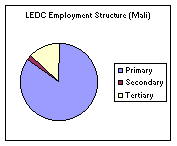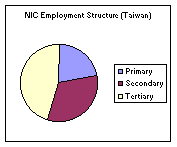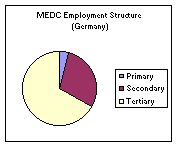Changes in Employment Structure
Primary Industry: industry concerned with extracting natural resources from the ground or the sea, e.g. agriculture, fishing, forestry, mining and quarrying. The output of such primary production often needs further processing.Secondary Industry: the manufacturing of goods using the raw materials from primary industry.
Tertiary Industry: does not produce anything but involves work in the service sector of the economy. It includes activities associated with commerce and distribution (wholesaling and retailing) as well as banking, insurance, administration, transport, tourism, health, education and entertainment services.
How do employment patterns differ between countries?
 |
 |
 |
| LEDC | NIC | MEDC |
| • High primary (farming)
• Little mechanisation on farms • Little manufacturing • In early stages of economic development • Informal service sector in the cities is quite strong |
• Strong manufacturing sector
• Many transnationals move to NICs to take advantage of cheap labour and land
|
• Farming mechanised
• Automation of manufacturing or transfer of manufacturing to NICs • Very strong tertiary sector with large numbers employed in health, education and tourism • Growth of jobs in the knowledge economy based on the processing of knowledge and information using telecommunications |
How do employment patterns change over time?
| Primary: decreases | Secondary: increases at first, then decreases | Tertiary: increases |
| • Mechanisation of farms reduces need for farm
workers. Rural workers migrate to the urban areas
• Raw materials become exhausted leading to loss of mining jobs • Rural depopulation of farmers in MEDCs. Workers prefer the better paid and less physically demanding jobs in the tertiary sector |
• Industrialisation initially requires a large
secondary workforce
• Factory jobs eventually replaced by automation • Manufacturing industries increasingly move from MEDCs to NICs where land and labour are cheaper |
• Large and growing informal service sector
in urban areas of LEDCs as workers migrate from the countryside
• As a country develops, demand grows for services such as health, education and tourism • Strong growth in MEDCs of jobs in the knowledge economy based on the processing of knowledge and information using telecommunications • Increase in producer services for manufacturing industry, e.g. market research
|
